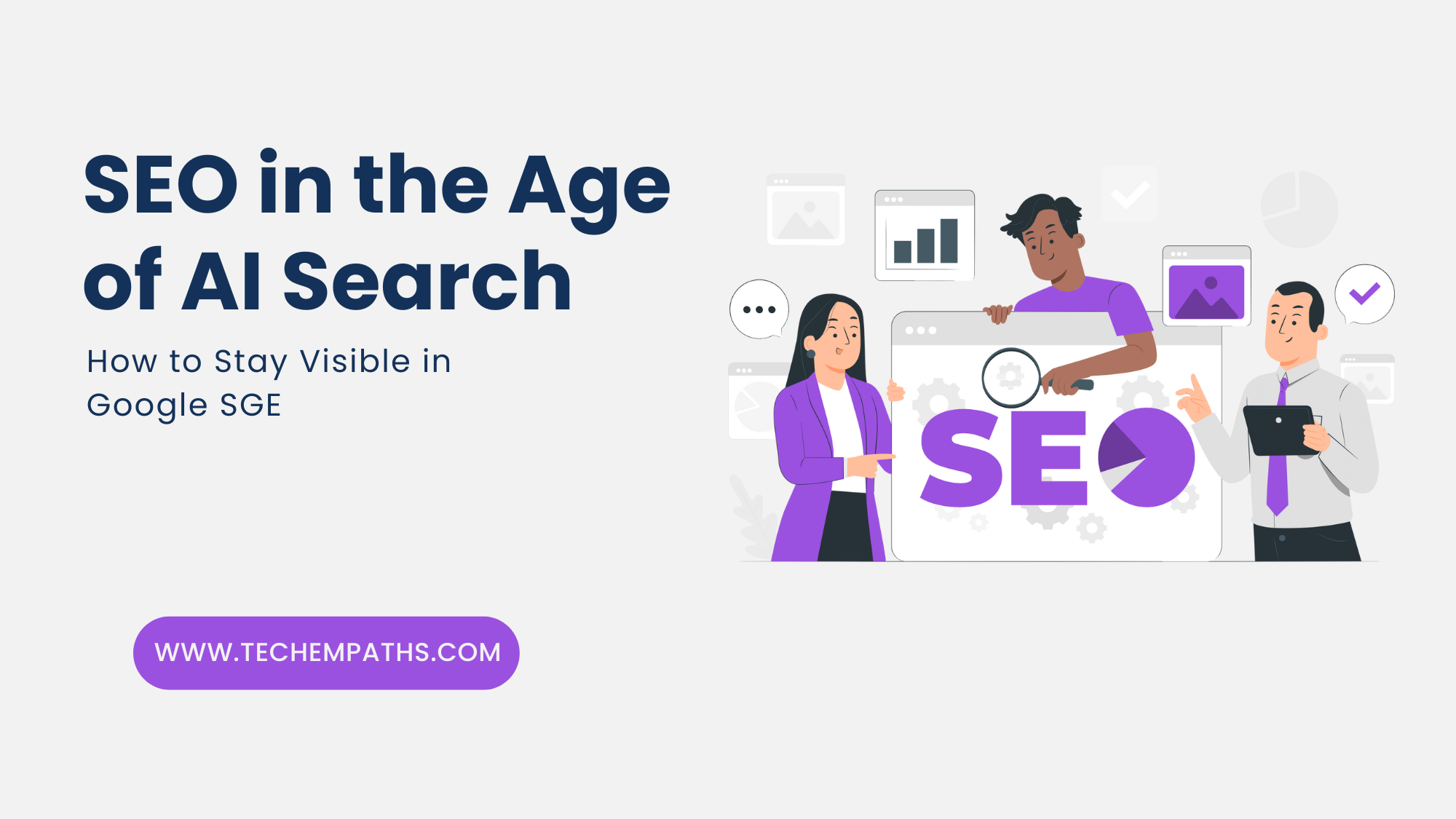Introduction: The Evolution of Search is Here
The digital landscape has always been dynamic, but the introduction of Google’s Search Generative Experience (SGE) marks a truly foundational shift in how we interact with search engines. Instead of a simple list of links, users now encounter AI-generated summaries, contextual answers, and deep content interactivity—all before they even click a website.
For SEOs, marketers, and content creators, this isn’t just a new feature—it’s a new paradigm. This article explores the implications of AI-powered search, the strategies you need to adapt, and how to thrive in Google’s post-algorithmic world where EEAT and semantic SEO reign supreme.
What is Google SGE (Search Generative Experience)?
Google SGE represents an AI-enhanced search experience designed to streamline user queries into structured, summarized, and synthesized answers. Leveraging Google’s PaLM and Gemini AI models, SGE processes natural language, understands context, and serves AI-generated insights from multiple sources.
Key SGE Features:
- AI-powered Answer Boxes: Summaries that blend information from various trusted websites.
- Cited Sources: Hyperlinked references to websites within the AI box.
- Interactive Q&A: Users can refine their questions, prompting deeper AI exploration.
This makes SGE both an opportunity and a challenge—your content has the chance to be directly cited in Google’s answer, or be completely bypassed.
The Impact of SGE on SEO and Organic Traffic
1. Click-Through Rates Are Shifting
Traditional CTRs are declining as users get answers directly from SGE. Even high-ranking pages may receive fewer visits unless they’re featured in AI citations.
Solution: Optimize for visibility inside the AI box. Provide factual, structured, and authoritative content Google’s AI can summarize.
2. Topical Authority Is Now Mandatory
Google favors websites that comprehensively cover a topic. SGE often references such “authority hubs” over thin, isolated blog posts.
Solution: Build content clusters—a pillar page supported by in-depth subtopics—all interlinked semantically.
3. Citations as the New Ranking Metric
Being cited in an SGE snippet is the new gold standard. AI looks for clarity, structure, and trustworthiness.
Solution: Use structured data, cite sources, and ensure content aligns with Google’s quality guidelines.
4. Deeper Competition with AI-Generated Content
You’re not just competing with other websites—you’re competing with Google’s AI itself. Generic or keyword-stuffed content has no place here.
Solution: Add first-person insights, original research, and expert commentary. Be human, credible, and unique.
EEAT in 2025: The Cornerstone of Visibility
Google’s algorithm updates consistently emphasize Experience, Expertise, Authoritativeness, and Trustworthiness (EEAT). In the SGE era, this is no longer a best practice—it’s a requirement.
How to Enhance EEAT in Your Content:
- Experience: Use real examples, case studies, photos, or screenshots.
- Expertise: Demonstrate qualifications, link to author profiles, and mention relevant experience.
- Authoritativeness: Get backlinks, mentions from trusted domains, and positive reputation signals.
- Trustworthiness: Use HTTPS, provide clear privacy policies, cite data, and avoid clickbait.
🧠 Remember: Google isn’t just crawling words—it’s evaluating your site’s credibility through a blend of on-site and off-site signals.
Optimization Strategies for Google SGE
1. Focus on Answer-Like Content Formats
Structure your content like the answers users expect:
- Use Q&A formats
- Place answers immediately after questions
- Provide concise summaries and deeper context in following paragraphs
2. Prioritize Semantic SEO Over Keywords
Instead of keyword stuffing, aim for:
- Entity-based optimization: Mention related terms, concepts, and synonyms
- Natural language: Align with how users speak and search
- Contextual coverage: Cover the broader topic in a meaningful way
3. Predict Follow-Up Questions
SGE encourages continued exploration. Anticipate related queries and answer them:
- What is Google SGE?
- How does SGE affect SEO?
- How do I get my site into SGE results?
Use tools like AlsoAsked, People Also Ask, and AnswerThePublic to source these questions.
4. Win Featured Snippets and AI Citations
Optimize your content to be both snippet- and AI-friendly:
- Add schema markup (FAQPage, HowTo, Article, etc.)
- Use clean, readable formatting
- Summarize answers in 40-50 word blocks
5. Leverage Multimedia for Enhanced Credibility
Visuals are increasingly shown in SGE responses:
- Create custom infographics and charts
- Use descriptive filenames and alt text
- Embed relevant videos, especially YouTube Shorts
Aligning with Google’s 2025 Core Update
The latest core updates underscore the importance of high-quality content, genuine user experiences, and trust. AI-generated fluff and recycled content are being deprioritized.
Key Takeaways from the Core Update:
- Authenticity Wins: Generic AI content is being filtered.
- UX Matters: Your page must be fast, mobile-friendly, and ad-light.
- Up-to-date Content: Freshness is a ranking factor. Revisit and revise older posts regularly.
Essential Tools for SGE-Ready SEO
Here are top tools to power your optimization in the age of AI search:
- Surfer SEO / NeuronWriter – Semantic and NLP-based content planning
- InLinks – For internal linking and entity optimization
- Google Search Console – To monitor CTR and performance
- PageSpeed Insights – Improve load times and UX
- AnswerThePublic / AlsoAsked – Discover related search questions
Future-Proof Your SEO Strategy: The New Playbook
1. Write for Users, Format for Machines
- Keep your tone conversational and helpful
- Use schema and clear formatting so AI can parse and summarize your work
2. Think in Topics, Not Just Keywords
- Develop content libraries on specific verticals
- Establish yourself as a go-to source on a subject
3. Invest in Originality
- First-party data
- Case studies and experiments
- Expert interviews or quotes
Final Thoughts: Adapt, Elevate, or Be Left Behind
AI search is not the future—it’s the present. With Google SGE leading the way, SEO must evolve from traditional techniques to strategies rooted in user trust, content quality, and topical authority. Your visibility depends on not just ranking high, but being recognized as a source worth citing by AI.
At Techemapths.com, we believe the next generation of SEO will be powered by human insights, optimized by AI, and driven by authentic value. The sooner you adapt, the further you’ll thrive.




Leave a Reply